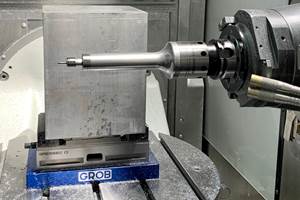Wire EDM for Dressing Metal-Bonded Wheels
The Studer WireDress system, which uses the wire “spark erosion process” to dress a metal-bonded grinding wheel while it is still mounted in the grinder, makes using these wheels more efficient and economical.
Share





Integrating the wire EDM process with a precision grinder may seem to produce an unlikely combination, but it made perfect sense to developers at Fritz Studer AG (a member of the United Grinding group, whose U.S. headquarters are in Miamisburg, Ohio). The company’s new Studer WireDress system uses the wire “spark erosion process” to dress a metal-bonded grinding wheel while it is still mounted in the grinder. WireDress opens up new possibilities for grinding with metal-bonded grinding wheels and substantially reduces nonproductive time in grinding operations.
Metal-bonded grinding wheels offer particular benefits when grinding difficult-to-machine materials such as high-alloy, hardened steels, tungsten carbides and ceramics. Such wheels offer superior dimensional and thermal stability, and more quickly dissipate the heat produced by grinding. The grinding wheels consist of a sintered metal matrix with embedded diamond or cubic boron nitride (CBN) grains. Because the metal bond holds the abrasive grains very well, these wheels can achieve very high removal rates.
However, dressing metal-bonded wheels can be a problem. The typical method using a silicon carbide dressing wheel, for example, often does not achieve satisfactory results, the company says. In addition, the grains are difficult to extract mechanically from the metal matrix and are sometimes damaged in the process. It is also not possible to restore the high grain protrusion that makes the grinding wheels so efficient when fresh. The extremely hard abrasive grains also lead to heavy wear of the dressing wheels.
In contrast, the wire EDM process is well suited as a dressing method for these wheels. It removes material by emitting extremely short direct-current pulses in quick succession. These pulses create intense discharges of electrical energy in the gap between electrode and workpiece. During each discharge, microscopic areas of the wheel’s metal bond are melted and flushed out of the gap as small particles by the dielectric fluid.
The WireDress dressing device is essentially a small wire erosion machine. Because it is integrated into the grinding machine and its control system, the grinding wheel does not have to be removed for dressing. In operation, the electrode wire travels tangentially past the periphery of the grinding wheel while maintaining a slight gap as it passes. No special dielectric fluid is needed because the normal supply of oil used during grinding provides this function. The wire is guided in a groove on the circumference of a thin, circular ceramic disc. The ceramic disc has a notch the point where the sparks jump between the wire and the grinding wheel. Intricate contours with internal radii of 0.2 mm and external radii of 0.05 mm can be generated on the wheel. Intricate contours with internal radii of 0.2 mm and external radii of 0.05 mm can be generated, and there is no mechanical contact between the wire (the dressing tool), the grain and the bond, and no negative effect on the abrasive grain itself.
With metal-bonded grinding wheels dressed in this way, it is possible to increase productivity by as much as 30 percent compared to grinding with resin or ceramic bonds. The high proportion of open grains that are exposed makes the wheel very free cutting, significantly reducing grinding pressure and wheel wear.
In addition to the necessary dressing functionalities, the interface between the WireDress control unit and the grinding machine’s control system contains a software program for intelligent profiling with path optimization.
Basic research and testing of this dressing method was carried out on the Studer S22, a grinding platform designed for the mass production of medium-sized workpieces. WireDress is also available on the S31 and S41 CNC universal cylindrical grinding machines.
Related Content
Orthopedic Event Discusses Manufacturing Strategies
At the seminar, representatives from multiple companies discussed strategies for making orthopedic devices accurately and efficiently.
Read MoreInside a CNC-Machined Gothic Monastery in Wyoming
An inside look into the Carmelite Monks of Wyoming, who are combining centuries-old Gothic architectural principles with modern CNC machining to build a monastery in the mountains of Wyoming.
Read MoreHow to Determine the Currently Active Work Offset Number
Determining the currently active work offset number is practical when the program zero point is changing between workpieces in a production run.
Read MoreHigh RPM Spindles: 5 Advantages for 5-axis CNC Machines
Explore five crucial ways equipping 5-axis CNC machines with Air Turbine Spindles® can achieve the speeds necessary to overcome manufacturing challenges.
Read MoreRead Next
Last Chance! 2025 Top Shops Benchmarking Survey Still Open Through April 30
Don’t miss out! 91ÊÓƵÍøÕ¾ÎÛ's Top Shops Benchmarking Survey is still open — but not for long. This is your last chance to a receive free, customized benchmarking report that includes actionable feedback across several shopfloor and business metrics.
Read MoreAMRs Are Moving Into Manufacturing: 4 Considerations for Implementation
AMRs can provide a flexible, easy-to-use automation platform so long as manufacturers choose a suitable task and prepare their facilities.
Read MoreMachine Shop MBA
Making Chips and 91ÊÓƵÍøÕ¾ÎÛ are teaming up for a new podcast series called Machine Shop MBA—designed to help manufacturers measure their success against the industry’s best. Through the lens of the Top Shops benchmarking program, the series explores the KPIs that set high-performing shops apart, from machine utilization and first-pass yield to employee engagement and revenue per employee.
Read More






















